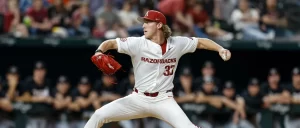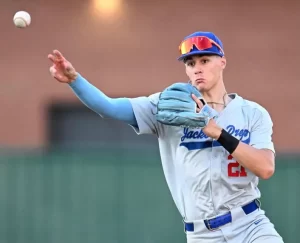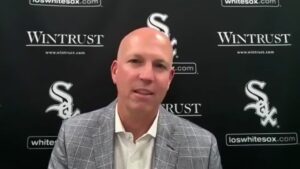White Sox Add 8 Prep Talents Due To Estimable Spending in Draft
It’s way too early to judge the draft classes of 2017 and 2018 much less the latest 2019 crop but the approach that the White Sox took in this year’s annual selection meeting is laudable. Nick Hostetler oversaw his 4th draft as the Director of Amateur Scouting for the club and he’s made subtle changes to his staff during that time. A noticeable shift in data collection has been present throughout the draft process as well as the addition of scouts in the form of more eyes on the ground which is atypical to the modified landscape throughout the industry.
Chatter about a shifting strategy for the college player heavy Pale Hose was prevalent within the draft media in the lead up to this year’s festivities. There was plenty of speculation about the front office being intrigued enough by a particular prep talent to pass up a more highly regarded college hitter. Ultimately, the White Sox selected the more polished bat and adding an Andrew Vaughn to the system appears to be a no brainer in retrospect. Selecting the true best player is generally the best outcome for clubs but under the current draft rules, it can have an effect on the amount of versatility the decision makers have with the rest of the draft class.
After seeing the totality of the 2019 draft haul for the White Sox, it’s evident that the scouting focus has been shifted but the old axioms of truth are still important. Hostetler preaches the necessity to take the “best player available” in the first round, especially in a public conversation. It could be assumed when Vaughn’s name came off the board that the college heavy approach used to insulate the system with talent in the previous three tries was going to be a preferred strategy once again. That wasn’t the case though. The White Sox signed 37 members of their 40 player draft class and 8 players were of the prep variety. In all, it was a wild deviation from what appeared to be a new trend preferred in the offices at 35th and Shields.
With the 3rd pick overall and a top four selection in every round, the White Sox were afforded a bonus pool amount of $11,565,500 to spend on their 2019 draft class. For the 2nd year in a row, the organization spent that amount and then some. Clubs are permitted to spend 5% over their total pool amount as long as they pay a 75% overage tax on the extra dollars spent. The franchise spent an additional $510,700 this year for a total hovering near $12.5 million. The White Sox will also pay the overage amount which in this case equals an extra $383,025. The White Sox aren’t the only club to take advantage of the spending rules but they should be commended for doing everything in their power to add as much talent as possible through this medium.
The approach that Hostetler and his staff employed was an odd one and was questionable even at its conclusion. It was correctly assumed that Vaughn would receive a bonus in excess of $7 million. Then the organization went away from consensus and drafted prep right hander Matthew Thompson with their 2nd choice. They deviated even further on day two by taking high school righty Andrew Dalquist and prep outfielder James Beard in successive rounds. To pay for those decisions, the scouting staff decided to take college seniors in rounds 5-10 and allocated a whopping $60,000 total for those prospects. When looking at a draft class, it’s imperative to focus on the totality of said class. Using the $12.5 million in bonuses, these would constitute as the club’s top 10 selections congruent with the money spent.
- 1. Andrew Vaughn 1B California ($7.2 million)
- 2. Matthew Thompson RHP Cypress Ranch HS, TX ($2.1 million)
- 3. Andrew Dalquist RHP Redondo Union HS, CA ($2 million)
- 4. James Beard OF Loyd Star HS, MS ($350K)
- 5. D.J. Gladney 3B Illiana Christian HS, IL ($225K)
- 6. Chase Krogman OF Liberty HS, MO ($190K)
- 7. Misael Gonzalez OF Leadership Christian Academy, PR ($185K)
- 8. Victor Torres C International Baseball Academy, PR ($175K)
- 9. Logan Glass OF Mustang HS, OK ($170K)
- 10. Caleb Freeman RHP Texas A&M ($150K)
The influx of prep performers is a welcomed addition for a farm system predominantly consisting of older college talent. Matthew Thompson and Andrew Dalquist are the most interesting names in the bunch even though they’ve yet to toe the rubber for an affiliate. The organization believes that both of these right handers possess top of the rotation ability and their paths through the system will be interesting to follow. James Beard has put his top of the scale speed on full display in rookie league games and he often works counts when at the dish. The results just haven’t matched the effort in 12 games as he’s only produced a triple slash line of .204/.291/.306.
Victor Torres and Misael Gonzalez have played in 9 and 14 contests respectively as well. Torres’ premium defensive skills have been apparent but he’s hit just .267/.313/.300 while Gonzalez has really struggled to the tune of a .539 OPS. Gladney’s selection in the 16th round was an interesting one because of his local affiliation and history with the ACE Program. The White Sox paid him $225K to keep him from his commitment to Eastern Kentucky. Perfect Game USA called Gladney an “athlete with a projectable build with room for more strength to be added”. D.J. is a right handed hitter that sports a “leg kick with a deep hand load and good bat speed”. His prodigious raw power has instantly translated to the back fields in Arizona. He’s one of the biggest developments of the season for the AZL White Sox with his 10 extra base hits and 5 home runs in 19 games played. Gladney is hitting .307/.349/.587 but has 29 strikeouts with only 3 walks in the early going. A promotion to the Advanced Rookie Affiliate in Great Falls, Montana, is not out of the question to end his year.
22nd-rder Logan Glass signs with @WhiteSox for $170k ($45k counts vs bonus pool). Oklahoma HS OF, 6-ft-4 & 215 pounds, plus raw power & athleticism. Kansas recruit. @MLBDraft
— Jim Callis (@jimcallisMLB) July 9, 2019
34th-rder Chase Krogman signs with @whitesox for $190k ($65k counts vs bonus pool). Missouri HS OF, hit over power but has some pop, solid speed. Missouri State recruit. @MLBDraft
— Jim Callis (@jimcallisMLB) July 9, 2019
It was announced recently that prep outfielders Logan Glass and Chase Krogman would also become members of the Chicago White Sox organization. High school players taken at this juncture of the draft’s third day often wind up on college campuses but the organization may have a trend forming after securing the services of Michigan prep Bryce Bush in the 33rd round in 2018 as well. Nick Hostetler deserves credit for believing in his area scouts and the area scouts deserve credit for staying on these players and knowing their intentions. Krogman is a 5’11” 180 pound outfielder from Liberty High School in Dardenne Prairie, Missouri. Glass is a 6’4″ 215 pound outfielder from Mustang High School in Mustang, Oklahoma. Both players will be joining the affiliate in the AZL in the near future.
Perfect Game calls Krogman an “outfielder with an athletic frame and strong build”. Chase has a “slightly crouched stance from the left side and uses a left leg trigger for timing” according to the publication. He shows good bat speed due to his quick hands. He possesses pull-side power but uses more of a whole field approach. The southpaw posted a 7.02 time in the 60-yard dash. He’s the all time leader in hits, homers, RBI, doubles and runs scored at Liberty High School. Chase hit .392 as a senior with 5 home runs and 34 RBI while earning a scholarship to play baseball at Missouri State. Krogman sits in the low-to-mid nineties with his fastball on the mound as well but it’s unclear whether or not he’ll take the mound for the White Sox as well.
Glass was ranked as the #4 overall outfield prospect in the state of Oklahoma according to Perfect Game. The White Sox will give the Oklahoma native $170K to buy out his commitment to Kansas. Logan is a 6’4″ 215 pound outfielder with a strong throwing arm. Glass hit .522 with 11 homers and 14 stolen bases from the right side for Mustang High School. The almost Jayhawk also pitched as a prep but his future will seemingly be in the outfield. Krogman and Glass will be joining a crowded outfield in Arizona that is packed with youngsters. They both had the chance to play college baseball and improve their draft stock for 2022 but they are both deciding to gamble on their athletic traits. These two signings add on to an already intriguing 2019 draft class and the trends that appear to be coming to fruition on the amateur side could bear fruit for the White Sox’s organization down the road.
Want to know right away when we publish a new article? Type your email address in the box on the right-side bar (or at the bottom, if on a mobile device) and click the “create subscription” button. Our list is completely spam free, and you can opt out at any time. Also, consider supporting FutureSox on Patreon! You can get early access to special articles and Patreon-only posts, in addition to more benefits you can read about here.






